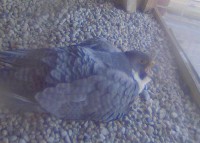Lawrence Peregrines: brood patch
April 20, 2018 in In the Nest Box, lawrence peregrines, Peregrine Falcons Eastern Massachusetts, Peregrine Falcons Massachusetts
 The peregrines started Friday morning with overcast skies, wind from the west at 6MPH and the temp at 37F. The forecast for the day ahead calls for partly sunny skies, with a high near 53. Northwest wind 9 to 14 mph, with gusts as high as 31 mph. The next few days are looking much warmer….finally! While taking a look just after 6:30 AM this morning, the female was incubating the eggs. She started to wail, and it looked like she was wailing loudly. She settled back down, and remained on the eggs for over an hour. Then she popped up and went out for a quick flight, an then returned right away. Keeping the eggs warm is a long, slow, and tedious process.
The peregrines started Friday morning with overcast skies, wind from the west at 6MPH and the temp at 37F. The forecast for the day ahead calls for partly sunny skies, with a high near 53. Northwest wind 9 to 14 mph, with gusts as high as 31 mph. The next few days are looking much warmer….finally! While taking a look just after 6:30 AM this morning, the female was incubating the eggs. She started to wail, and it looked like she was wailing loudly. She settled back down, and remained on the eggs for over an hour. Then she popped up and went out for a quick flight, an then returned right away. Keeping the eggs warm is a long, slow, and tedious process.
 So how is it that the peregrines provide constant heat to the eggs? Many bird species, including peregrine falcons, have a special adaptation that helps them keep their eggs warm. The birds develop featherless areas on their breast called brood patches. These areas develop thickened skin and an increased blood flow that helps the birds pass body heat along to the developing embryos inside the eggs. Male peregrine falcons also develop brood patches and help with incubation, but as the female will do the majority of this work her brood patch is much more developed.
So how is it that the peregrines provide constant heat to the eggs? Many bird species, including peregrine falcons, have a special adaptation that helps them keep their eggs warm. The birds develop featherless areas on their breast called brood patches. These areas develop thickened skin and an increased blood flow that helps the birds pass body heat along to the developing embryos inside the eggs. Male peregrine falcons also develop brood patches and help with incubation, but as the female will do the majority of this work her brood patch is much more developed.
Literature cited: Richmond Falcon Cam, Brood Patches, https://www.dgif.virginia.gov/falcon-cam/2012/04/brood-patches/ Virginia Department of Game and Inland Fisheries, P.O. Box 90778, Henrico, VA 23228-0778
